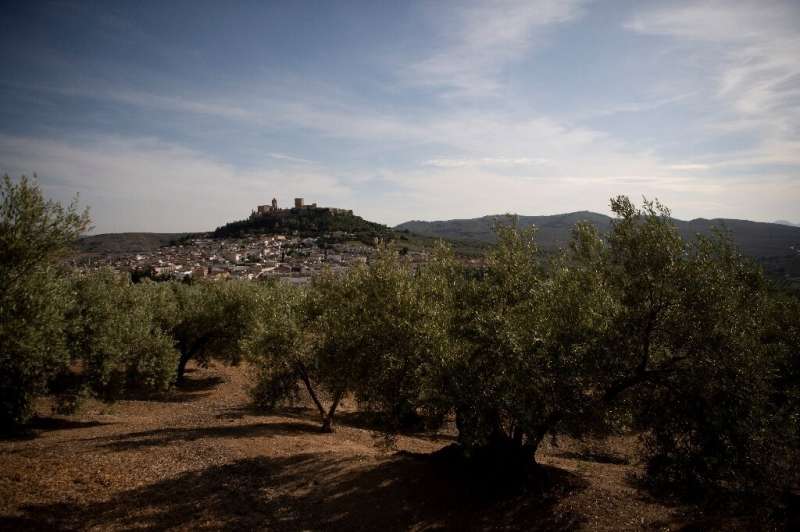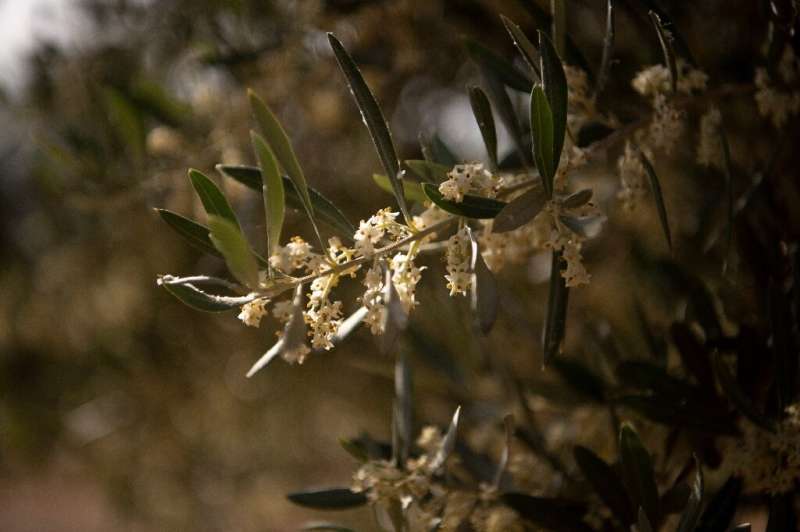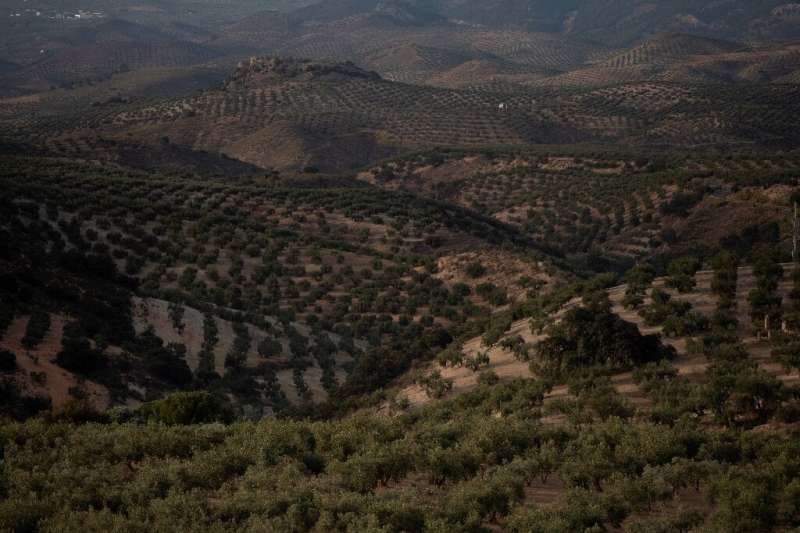Drought spells 'catastrophe' for Spain's olive harvest

An ongoing drought and soaring temperatures have unleashed fears of an olive "catastrophe" in Spain, the world's largest producer of olive oil, which suffered a very difficult year in 2022.
"It's barely rained since January. The ground is very dry," worries Cristobal Cano, secretary general of the small farmers' union (UPA) in the southern region of Andalusia, the heart of Spain's olive oil industry.
Cano, who owns 10 hectares of olive trees in Alcala la Real near Granada, has never seen such a worrying situation in the 20 years he's been a farmer.
"If something doesn't change radically in the next few weeks, it's going to be a catastrophe," he warned.
According to the AEMET weather agency, accumulated rainfall since October 1 has been 25 percent lower than normal across Spain and 50 percent lower in most of Andalusia, where reservoirs are at 25 percent capacity.
And the situation worsened at the end of April, when an early heatwave brought exceptionally high temperatures that saw the mercury hit 38.8 degrees Celsius (101.8 degrees Fahrenheit) in southern Spain.
"This happened as the olive trees were in bloom," says Rafael Pico, director of Asoliva, the Spanish association of olive oil producers and exporters, who fears the blooms will dry up.
"If there are no flowers, there's no fruit. And if there's no fruit, there's no oil."

'On the brink of collapse'
For Spain—which normally supplies 50 percent of the world's olive oil and exports close to 3.0 billion euros ($3.3 billion) worth every year—the situation is even more worrying given the sector's disastrous output in 2021-2022.
During that season too, a lack of rain and extreme temperatures saw olive oil production plummeting 55 percent to 660,000 tonnes, compared to 1.48 million tonnes in 2021-2022, agriculture ministry figures show.
The scene is set to play out again this year.
"Looking at the forecasts, it's almost a given—it's going to be another grim year," says Rafael Sanchez de Puerta, head of Dcoop, Spain's leading olive cooperative.
If the predictions prove true, it could spell the end for many olive farms.
"We can cope with one difficult year. It's a natural part of the growing cycle. But two years in a row will be a disaster. Many are on the brink of collapse," he says.
With the cost of machinery, paying salaries and repaying loans, "farmers need liquidity" to remain afloat, says Asoliva's Pico, recalling that many in Spain live from olive oil production.

Runaway prices
For consumers, the outlook is also bleak.
"The global price of olive oil depends largely on Spain," says Pico.
In recent months, the price of oil has jumped.
"In mid-April, olive oil was selling at 5,800 euros ($6,400) per tonne, up from 5,300 euros in January," says Fanny de Gasquet of Baillon Intercor, a brokerage firm specialising in oils and fats.
In January 2022, it was selling at 3,500 euros.
And the upward trend looks set to continue.
In Andalusia, young olive trees "don't have sufficiently developed roots to be able to extract water" from deep underground, meaning "there will be losses" that will have an impact on production over the next two or three years, she warns.
At the end of 2022, the Spanish government moved to lower VAT on olive oil from 10 percent to five percent as part of a package of measures to help consumers in the face of soaring inflation.

And to help farmers cope with the drought, the government has reduced the sector's income tax by 25 percent.
But for many, it's too little in the face of the looming crisis.
"Lowering taxes for people who will have almost no income is of little use to them," says Dcoop's Sanchez de Puerta, calling for more ambitious moves to combat "a drought that is lasting longer than it should".
© 2023 AFP
yesterday

A man sunbathes on a hot spring day in Madrid, Spain, on April 18, 2023. Drought-stricken Spain says last month was the hottest and driest April since records began in 1961. The State Meteorological Agency, said Monday May 8, 2023 the average daily temperature in April was 14.9 degrees Celsius (58.8 Fahrenheit), that is 3 degrees Celsius above the average. (AP Photo/Paul White, File)
MADRID (AP) — Drought-stricken Spain says last month was the hottest and driest April since records began in 1961.
The State Meteorological Agency, known by the Spanish acronym AEMET, said Monday the average daily temperature in April was 14.9 degrees Celsius (58.8 Fahrenheit), that is 3 degrees Celsius above the average.
AEMET said average maximum temperatures during the month were up by 4.7 Celsius.
Rainfall was a fifth of what would normally be expected in the month, making it the driest April on record in Spain.
Last year was Spain’s hottest since record-keeping started in 1961, and also the country’s sixth driest.
Three years of scant rainfall and high temperatures put the country officially into long-term drought earlier this year.
A flash study by a group of international scientists last week found that record-breaking April temperatures in Spain, Portugal and northern Africa were made 100 times more likely by human-caused climate change and would have been almost impossible in the past.
The government has requested emergency funds from the European Union to support farmers and ranchers whose crops are being affected by the situation.
By JENNIFER O'MAHONY and SETH BORENSTEIN

1 of 6
FILE - A man cools himself at a fountain in Seville, Spain, April 27, 2023. Record-breaking April temperatures in Spain, Portugal and northern Africa were made 100 times more likely by human-caused climate change, a new flash study found. (AP Photo/Santi Donaire, File)
MADRID (AP) — Record-breaking April temperatures in Spain, Portugal and northern Africa were made 100 times more likely by human-caused climate change, a new flash study found, and would have been almost impossible in the past.
A group of international scientists did a rapid computer and statistical analysis of a late-April heat wave that stretched across the Iberian peninsula into Algeria and Morocco. The four countries experienced temperatures as high as 36.9 degrees Celsius (98.4 degrees Fahrenheit) to 41 degrees Celsius (105.8 degrees Fahrenheit) degrees.
Study lead author Sjoukje Philip of the Royal Netherlands Meteorological Institute said in a briefing that a weather event this extreme “would have been almost impossible in the past, colder climate,” adding: “We will see more intense and more frequent heat waves in the future as global warming continues.”
Because the analysis released Friday was one of the quickest ever — the heat still hasn’t subsided much — the study by World Weather Attribution is not peer reviewed, which is the gold standard for science. But the team of WWA scientists do these quick studies using scientifically accepted techniques and often get them published later in peer-reviewed journals.
The regions in the study are all suffering from a multi-year drought, which can exacerbate high temperatures, the scientists said.
Currently, 27% of Spanish territory is in either the drought “emergency” or “alert” category and water reserves are at 50% of capacity nationally. The average dam storage in Morocco is at similarly low levels, and in Tunisia many homes have water cuts during the day.
Farmers across the Western Mediterranean have warned that poor harvests are likely, in some regions for the sixth year running.
The study also said the extreme heat in Europe is rising faster than computer models had projected. The same thing happened in the Pacific heat dome, so scientists who create computer models need to go back and rethink their overly conservative projections, said University of Washington’s Kris Ebi, who wasn’t part of the study, but praised it.
The scientists compared real life April temperatures to a simulated world without climate change. They found that a heat wave like the one the Western Mediterranean suffered in April would have been more than two degrees Celsius (3.6 degrees Fahrenheit) less severe in a world without coal, oil and gas pollution trapping heat.
The study will also help inform governments preparing for the earlier onset of extreme hot weather, with the aim of preventing deaths and unrolling heat awareness campaigns. Last year, at least 15,000 people died in Europe because of extreme hot weather, according to the World Health Organization, with Spain one the countries worst affected.
“When we can send out warnings with calibrated messaging, that allows people to accurately perceive their personal risk, that can lead to personal behavioral changes,” said Roop Singh of the Red Cross Red Crescent Climate Centre, another of the study’s authors.
Changes include access to air conditioning in schools, monitoring heat-related hospital admissions and advising citizens to avoid outdoor sports at certain hours of the day, she said.
The results of the study make sense and are important, according to three outside climate scientists.
“The world is approaching the moment when nearly all heat waves will have a climate change fingerprint,” Ebi told The Associated Press in an email. “In the meantime, these kinds of analyses are valuable for moving policymakers and justifying investments.”
Studies like these are important, but “’it’s also now like asking if the dog with berries on its face got into the pie cooling on the counter,” said North Carolina State Climatologist Kathie Dello, who wasn’t part of the study.
While some scientists question the value of looking for climate change’s fingerprint in studies like this, saying global warming is changing everything, Stanford University climate scientist Rob Jackson, who was not part of the study, said this type of analysis has value.
“Attribution is the only tool we have to understand whether extreme weather is inflamed by climate change,” Jackson said in an email. “Rare weather events are becoming more and more ‘normal.’ Climate change has loaded the weather dice.”
___ Borenstein reported from Kensington, Maryland
___ Follow AP’s climate and environment coverage at https://apnews.com/hub/climate-and-environment ___ Follow Seth Borenstein on Twitter at @borenbears and Jennifer O’Mahony at @jaomahony
___ Associated Press climate and environmental coverage receives support from several private foundations. See more about AP’s climate initiative here. The AP is solely responsible for all content.

No comments:
Post a Comment